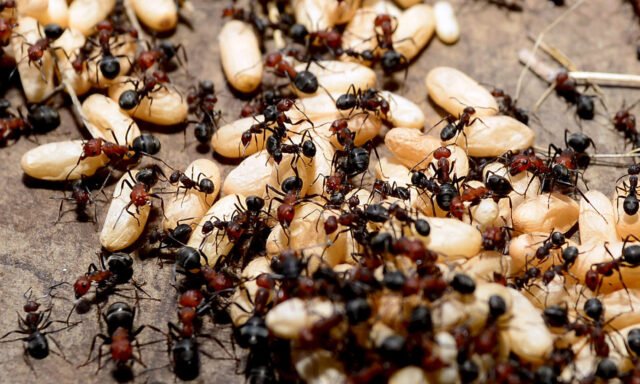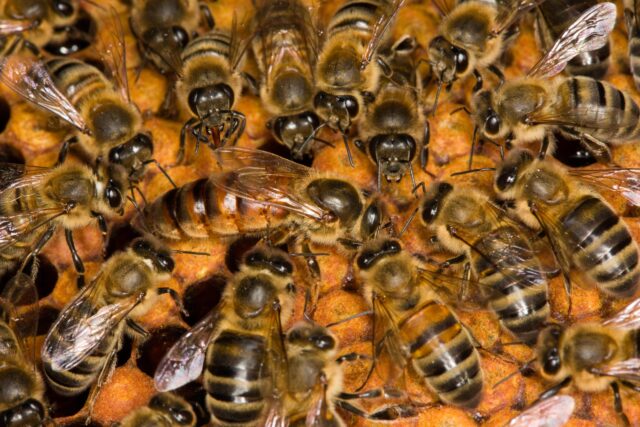Insects, like all other species, follow the theory of natural selection. What happens when the infections attack entire colonies and it spreads like wildfire? (looking at you, COVID-19 in India)
The Case Studies
An American bee-keeper, Edward Brown, had an experiment conducted for American Foulbrood (AFB), a disease caused by the bacterium Paenibacillus larvae, which kills the larvae and pupae of the European honey bee (Apis mellifera).
Under normal circumstances, bee-keepers usually burn and destroy diseased colonies quickly, leading to a missed chance of developing immunity through natural selection.
Brown purchased a large number of empty combs from beekeepers whose colonies had been killed by the disease, and let his bees steal any leftover honey there was. While extracting the honey, the bees also contracted the diseases that came along with it.
Many of Brown’s bees died, but those who stayed alive were resistant to AFB through natural selection.
Ants combat this disease using a combination of two methods. According to researchers Nathalie Stroeymeyt, Anna V. Grasse, and Sylvia Cremes, the first one involves limiting social interactions.
They hypothesized that networks of social interaction in an ant colony should be so designed that, in addition to permitting efficient communication and division of labour, they should also minimise the spread of disease. They called this battle-ready preparedness ‘constitutive organisational immunity’.
The second one has “sanitary ants” as prudent caregivers to the colony. They specialise in caring for the sick by grooming the infected individuals to remove external parasites and applying antimicrobial poisons onto the infected individuals’ bodies.

Wasps should not be left out, as even they have a planned fortification against infectious diseases. Nitika Sharma asked a prudent question if the queen wasp had a favorite place to sit inside a colony.
Her research showed that the non-random space used by the wasps is designed for efficient food distribution while simultaneously minimising the spread of disease. The Queen stays far away from the workers, for they are most likely to be carrying the disease.
The Observations
Colonies take precautions to protect their queen at all costs. However, in the case of ants, they lick their infected mates to remove the fungal spores before the pathogens sprout and grow.
Such grooming dilutes the infection, spreading it thinly across the entire colony. The healthy ants share the pathogen to unload the burden on the sick ones, thus making them immunized against the pathogen.
Also Read: Study Reveals Honeybee Venom Can Cure 2 Types Of Breast Cancer Easily
Comparing humans to ants, I must say that humans are severely selfish and lack the innate team spirit to beat a pathogen together. But then again, most insects develop their immunity way faster than humans.

The best defense in these scenarios is a combination of organizational immunity along with social herd immunity. The main purpose is to keep the queen alive at all costs.
The Inferences
The infection history of a host matters the triggered immune response systems. Previous infections or vaccinations can immunize and protect hosts against further infections of the same homologous pathogen, a phenomenon known as “immune memory” in vertebrae and “immune priming” in invertebrates
Insects with low-level infection help with sanitary care. The behavioral plasticity displayed by the ants, which is dependent on the combination of their infection state and current risk of pathogen contraction, resulted in a reduced transfer of the harmful heterologous, but not the non-detrimental, homologous pathogen compared with noninfected control insects.

The low–level–infected insects were more aggressive toward their nestmates indicates that the infection itself or a physiological change due to an immune response alters the level of aggression in insects.
Similar to our findings in insects, higher irritable or hostile behavior can also be observed in infected vertebrates, including humans. These changes in behavior form a part of general sickness behavior that also includes fatigue, depression, and reduced social integration.
Such changes in the behavior are generally considered to be triggered by the immune system through neural and circulatory pathways. In insects, a loss of attraction to social cues from the nest or nestmates, and hence social isolation from the colony.
Image Sources: Google Images
Sources: Scientific American, The Wire, Science Direct
Find the Blogger: Shouvonik Bose
This post is tagged under: honey bees, nifty bees, nifty, gold bees, nifty bees share, nifty bees price, nifty bees share price, gold bees share price, gold bees price, gold bees share, nifty share price, honey bee bite, honey bee movie, honey bee sting, queen honey bee, honey bee hive, honey bee house, honey bee in hindi, honey bee images, honeybee, honey bee drawing, about honey bee, insects, colonies, ants, queen bee
Also Recommended:































